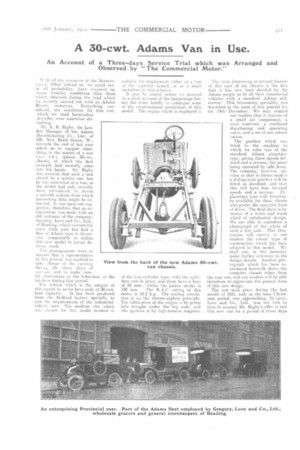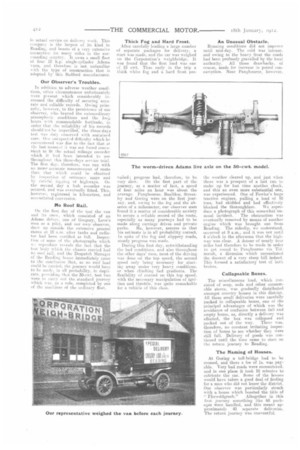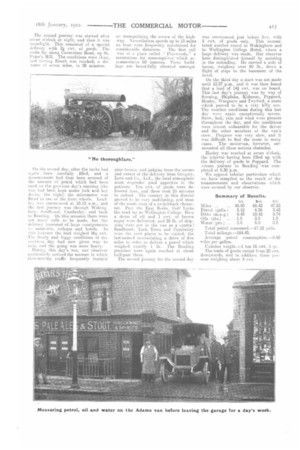A 30-cwt. Adams Van in Use.
Page 11

Page 12

Page 13

If you've noticed an error in this article please click here to report it so we can fix it.
An Account of a Three-days Service Trial which was Arranged and Observed, by "The Commercial Motor."
With all the resources of the Meteorological Office behind us, we could not, in all probability, have conjured up worse weather conditions than those which obtained during the trial which we recently carried out with an Adams 30-cwt. motorvan. Everything considered, the conditions for this test, which we shall hereinafter describe, were somewhat disturbing.
Mr. A. B. Rigby, the London Manager of the Adams Manufacturing Co., Ltd., of 106. New Bond Street, W., towards the end of last year asked us to suggest something in the nature of a test for the Adams 30-wt. chassis, of which the first example had recently come into his hands. Mr. Rigby was anxious that such a test should be a service one, but be was somewhat at a loss, as the model had only recently been introdueed, to devise a sellable scheme from whieh interesting data might be extracted. It was upon our suggestion, therefore, that an arrangement was made with an old customer of the company, Gregory, Love and Co., Ltd., of Reading, which concern for some while past has had a fleet of Adams vans in its service. temporarily to utilize this new model in actual delivery work.
el'he arrangements were so framed that a representative of this journal was enabled to take charge of the running during the three days of service, and to make careful observation of the behaviour of the machine during that period.
The vehicle which is the subject of this report is, as we have said, of 30-cwt. load rapacity. It has been produced from the Bedford factory specially to suit the requirements of the industrialvehicle user. The medium size which was chosen for this model renders it suitable for employment either as a van of the eapacity named, or as a small motorbus or char-it-banes.
It may be useful, before we proceed to a short account of the happenings during the trial, briefly to catalogue some of the constructional particulars of this model. The engine which is employed is of the four-cylinder type, with the cylinders cast in pairs, and these have a bore of 88 mm., whilst the piston stroke is 120 nun. The R. A.G. rating of this motor is 19.2 h.p. The cooling circulation is on the thermo-syphon principle. The lubrication of the engine is by pump into troughs under the big ens, and the ignition is by high-tension magneto.
The most interesting structural feature of this part of the chassis is the fart that it has now been decided by the Adams people to fit all their commercial vehicles with a standard Adams selfstarter. This interesting speciality was described in the issue of this journal for the 14th December. We may remind our readers that it consists of a small air compressor, a steel reservoir, a combined distributing and operating valve, and a set of nonereturn valves.
The gearbox which was fitted to the machine to which we refer was of the standard Adams planetary type, giving three speeds forward and a reverse, the gears being operated by side lever. The company, however, advises us that in future models a sliding-type gearbox will be fitted as standard, and thatthis will have four forward speeds and a reverse. Th. planetary type will, however, he available fur those elieets who prefer the epicyclic form of drive. The final drive is by means of a worm and worm wheel of substantial design. We are able to reproduce a photograph of the whole of such a live axle. This illustration will convey to our readers the robust type of construction which has been adopted in this model. We shall not, in this instance, make further reference to the design details. Another photograph which has been reproduced herewith shows the complete chassis taken from the rear end, and our readers will he able therefrom to appreciate the general lines of this new design.
The test took place during the last month of 1911, and, as the busy Christmas period was approaching, Gregory, Love and Co., Ltd., \VOA not loth to turn to account Mr. Rigby's offer to run this new van for a period of three days in actual service on delkery work. This company is the largest uf its kind in Reading. and boasts of a very extensive connection for many miles in the surrounding country. Ii, owns a small fleet of four 10 h.p. single-cylinder Adams vans, and therefore is not unfamiliar o itla the type of construction that is adopted by this Bedford manufacturer.
Our Observer's Troubles.
In addition to adverse weather conditions, other circumstances unfortunately were present which • considerably increased the difficulty of securing accurate and reliable records. Owing primarily, however, to the persistence of our observer, who braved the extraordinary atmospheric conditions and the long hours with commendable fortitude, in order that the reliability of his records Should not be imperilled, the three-days test was dnly observed with sustained care. One tmexpeeted difficulty which he encountered was due to the fact that at tIll last mommit it was not found COnVe'Client to fit the actual mileage recorder which it had been intended to use throughout this three-days service trial. The first. day, therefore, was run with HO more, accurate measurement of route than that whit+ could be obtained by inspectieu of ordnance mans and by careful logging of highways. On the second day a hub recorder was secured, and was eventually fitted. This, however, registered in kilometres, and necessitated cenversien.
No Roof Rail.
On the first day of the test the van arid its crew, which consisted of an Adams driver, one of Gregory, Love's men as a pilot, and our own observer, drew up outside the extensive general stores at 10 a.m, after tanks and radiator had been certified as full. Inspection et some of the photographs which wf reproduce reveals the fact that the test body which the chassis carried had no roof rail, and the Despatch Manager of the Reading house immediately came to the conclusion that, as no roof load could be carried, the journey would have to be made, in all probability, in duplicate. providing that the 30-cwt. test van were to carry Ont the standard on which was, as a rule, completed by one of the machines of the ordinary fleet.
Thick Fog and Hard Frost.
After carefully loading a large number of separate packages for delivery, a start was made, and the car was weighed on the Corporation's weighbridge. It was found that the first load was one of 15 cwt. Thus early in the trip a thick white fog and a hard frost pre vaned; progress had, therefore, to be very slow. On the first part of the journey, as a. matter of fact, a speed of four miles an hour was about the average. Panghourne, Basildon, Streetley and Goring were on the first journey, and, owing to the fog and the absence of a mileometer, our observer soon found it a matter of considerable anxiety to secure a reliable record of the route, especially as many journeys had to be made along carriage drives and private parks. He, however, assures us that his estimate is in all probability correct. In spite of the fog and slippery roads, steady progress was made.
During this first day, notwithstanding the bad conditions, arid also throughout the other days' runs, most of the driving was done on the top speed, the second speed only being necessary for starling away under very heavy conditions, or when climbing bad gradients. The flexibility of control on this top speed, with the necessary manipulation of ignition and throttle. was quite remarkable for a vehicle of this class.
An Unusual Obstacle.
Running conditions did not improve until mid-day. The cold was intense, and owing to the heavy frost the roads had been profusely gravelled by the local authority. All these drawbacks. of course, made for increase in petrol consumption. Near Pangbourne, however,
the weather cleared up, and just when there was a prospect of a fast run to make up for lost time another check, and this an even more substantial one, was experienced. One of Fowler's huge traction engines, pulling a load of 10 tons, had skidded and had effectively blocked the thoroughfare. We reproduce a photograph of this somewhat un usual incident. The obstruction was eventually removed by means of another engine which was brought out from Beading, The sideslip, we understand, occurred at 9 a.m., and it was nnt until 4 o'clock in the afternoon that the highway was clear. A detour of nearly four miles had therefore to be made in order to get round to Pangbourne via Tidmarsh, a diversion which necessitated the desoent of a very steep hill indeed. This formed a satisfactory test of both brakes,
Collapsable Boxes.
The miscellaneous load, which consisted of soap, soda and other consumable stores, was gradually distributed amongst country houses in this district. All these small deliveries were carefully packed in collapsable boxes, one of the principal advantages of which was the avoidance of confusion between full and empty boxes, as, directly a delivery was effected, the box was collapsed and
packed out of the way. There was, therefore, no constant irritating inspection of boxes to see whether they were still full. Delivery of goods was continued until the time came to start on the return journey to Reading.
The Naming of Houses.
At Goring a toll-bridge had. to be crossed, and there a fee of is. was payable. Very bad roads were encountered, and in one plaoe it took 10 minutes to extricate the car. Some of the houses would have taken a good deal of finding for a man who did not know the district. Our observer was particularly struck with a house which boasted the title of " Ffrrwddgrech." Altogether in this first journey something like 60 packages were handled, and this meant approximately 40 separate deliveries. The return journey was uneventful.
The second journey was started after seven o'clock at night, and then it was moonlight. This consisted of a special dclivery with 2i cwt. of goods. The route lay along Caversham Road, up St. Peter's Hill. The conditions were clear, and Ooring Heath was reached, a distance of seven miles, in 28 minutes.
On the second day, after the tanks had again been carefully filled, and a measurement had thus been secured of the amount of petrol which had been used im the previous day's running (the van had been kept under lock and key during the night) the mileometer was fitted to one of the front wheels. Loading NV;15‘. commenced at 10.15 a.m., and the first journey was through Wokingham. Sandhurst, Camberley, and back to Reading. On this occasion there were not many calls to be made, butthe delivery consisted of large consignments to sanatoria, colleges and hotels. In this instance the load weighed 26i cwt. The frosty and foggy conditions of the previous day had now given way to rain, and the going was more heavy.
During this day's run, our observer particularly noticed the manner in which_ slow-moving traffic frequently insisted on monopolizing the crown of the highway. Nevertheless speeds up to 15 miles an hour were frequently maintained for considerable distances. The first call was at. a place called " Pinewoods," a sanatorium for consumptives which aeccmmodates 60 inmates. These buildings are beautifully situated amongst
pine forests, and judging from the nature and extent of the delivery from Gregory, Love and Co., Ltd., the local atmosphere must engender good appetites in the patients. Ten cwt. of goods were delivered here, and these took 25 minutes to unload. The country in this district proved to be very undulating, and most of the roads were of a switchback character. Past the East Berks. Golf Links the road lax. to Wellington College. Here a drum oi oil and 1 cwt. of brown sugar were delivered. and 28 lb. of drip. ping' were pit in the van as a contra! Sandhurst., York Town and Camberley were the next places to be visited, the last-named necessitating a drive of five miles in order to deliver a parcel which weighed exactly 1 lb. The Reading premises were again reached at about half-past three.
The second journey for the second day was commenced juat before five, with 5 cwt. of goods only-. This necessitated another round to Wokinghain and to Wellington College Hotel, where a large delivery was made. Our observer here distinguished himself by assisting in the unloading. De carried a aide of bacon, weighing over 60 lb., down a flight of steps to the basement of the hotel.
On the third day a start was not made until 12.27 p.m., and it was then found that a load of 141 cwt. was on board. This last day's journey was by way of Sunning, Shiplake, Kidmore, Peppard, Henley, Wargrave and Twyford, a route which proved to be a very hilly one. The weather conditions during this last day were again exceptionally severe. Snow, hail, rain and wind were present throughout the day, and the conditions were almost unbearable for the driver and the other members of the van's crew. Progress was very slow, and it was difficult to find the wine in many cases. The motorvan, however, surmounted all these serious obstacles.
Henley was reached at seven o'clock, the interval having been filled up with the delivery of goods in Peppard. The return journey to Reading was completed at 8.30 p.m.
We append tabular particulars which we have compiled as the result of the measurements and observations which were secured by our observer.
Average petrol consumption.-9.60 miles per gallon.
Unladen weight.-1 ton 16 cwt. 3 ...Ir.
The loads of goods varied from 22 cwt. downwards, and in addition three persons weighing about 4 cwt.






















